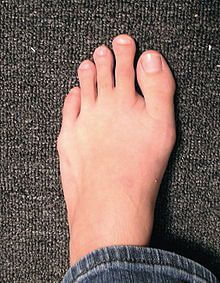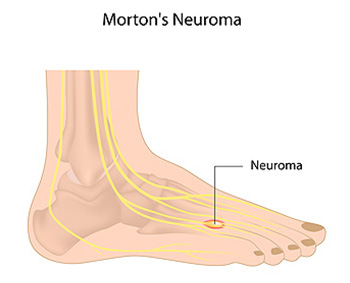bfdadmin
What Does a Partial Matricectomy Look Like?
Many of our patients especially are concerned about the cosmetic appearance of the toenail once the ingrown border is gone. Actually it is very difficult to even see this and be able to tell what side has been done permanently. Here is a photograph of a patient who had ingrown toenails removed (partial matricectomy procedures) from both the medial (inside) and lateral (outside borders) of the right great toenail and the medial or inside border of the left great toenail. See if you can tell the difference, most patients really can't tell the difference. Or they have to look very close to be able to tell the difference.

If you have questions about these treatments please let us know. We treat problems like this daily. Sometimes we see and treat 5 or more patients with this procedure on a given day. Give us a call at 425-391-8666 or make an appointment online today.
Neuromas - How To Treat Them


Morton's Neuroma (Intermetatarsal Neuroma)
What Is a Neuroma?
A neuroma is a thickening of nerve tissue that may develop in various parts of the body. The most common neuroma in the foot is a Morton’s neuroma, which occurs between the third and fourth toes. It is sometimes referred to as an intermetatarsal neuroma. “Intermetatarsal” describes its location in the ball of the foot between the metatarsal bones. Neuromas may also occur in other locations in the foot.
The thickening, or enlargement, of the nerve that defines a neuroma is the result of compression and irritation of the nerve. This compression creates enlargement of the nerve, eventually leading to permanent nerve damage.
Causes Anything that causes compression or irritation of the nerve can lead to the development of a neuroma. One of the most common offenders is wearing shoes that have a tapered toe box, or high-heeled shoes that cause the toes to be forced into the toe box.
People with certain foot deformities – bunions, hammertoes, flatfeet, or more flexible feet – are at higher risk for developing a neuroma. Other potential causes are activities that involve repetitive irritation to the ball of the foot, such as running or court sports. An injury or other type of trauma to the area may also lead to a neuroma.
Symptoms If you have a Morton’s neuroma, you may have one or more of these symptoms where the nerve damage is occurring:
· Tingling, burning, or numbness
· Pain
· A feeling that something is inside the ball of the foot
· A feeling that there’s something in the shoe or a sock is bunched up
The progression of a Morton’s neuroma often follows this pattern:
· The symptoms begin gradually. At first they occur only occasionally, when wearing narrow-toed shoes or performing certain aggravating activities.
· The symptoms may go away temporarily by removing the shoe, massaging the foot, or by avoiding aggravating shoes or activities.
· Over time the symptoms progressively worsen and may persist for several days or weeks.
· The symptoms become more intense as the neuroma enlarges and the temporary changes in the nerve become permanent.
Diagnosis
To arrive at a diagnosis, the foot and ankle surgeon will obtain a thorough history of your symptoms and examine your foot. During the physical examination, the doctor attempts to reproduce your symptoms by manipulating your foot. Other tests or imaging studies may be performed.
The best time to see your foot and ankle surgeon is early in the development of symptoms. Early diagnosis of a Morton’s neuroma greatly lessens the need for more invasive treatments and may avoid surgery.
Non-surgical Treatment
In developing a treatment plan, your foot and ankle surgeon will first determine how long you’ve had the neuroma and evaluate its stage of development. Treatment approaches vary according to the severity of the problem.
· Icing. Placing an icepack on the affected area helps reduce swelling.
· Activity modifications. Activities that put repetitive pressure on the neuroma should be avoided until the condition improves.
· Medications. Oral nonsteroidal anti-inflammatory drugs (NSAIDs), such as ibuprofen, may be recommended to reduce pain and inflammation, or topical compounds.
· Over the Counter nerve medications. We highly recommend nutritional supplements that help with nerve inflammation.
· Bracing. Temporary offloading braces are helpful.
· Prescription custom orthotics devices. Custom molded prescription custom orthotics devices provided by your foot and ankle surgeon provide the support needed to reduce pressure and compression on the nerve.
· Injection therapy. Treatment may include injections of cortisone, local anesthetics or other agents. Usually the first line therapy is alcohol injections in combination with the prescription custom orthotics both together are extremely successful.
When Is Surgery Needed?
Surgery may be considered in patients who have not responded adequately to non-surgical treatments. Your foot and ankle surgeon will determine the approach that is best for your condition. The length of the recovery period will vary, depending on the procedure performed.
Minimally Invasive Bunion Procedures

I get quite a few questions from patients each week pertaining to minimally invasive bunion procedures. The idea of minimally invasive surgery is attractive to patients as it usually means less healing time and smaller scars. The concept of a minimally invasive bunion has been around for decades and continues to come in and out of favor. The major problem I see is that patients often can find a physician willing to do this procedure when it is not an appropriate procedure to select i.e. the patient has a very large bunion or other complicating factors like a flatfoot.
I find the minimally invasive bunion procedure to be reliable and easily producible but proper patient selection is of the utmost importance. I see hundreds of patients a year and am happy to provided consultations or second opinions on bunions and bunion surgery. Our practice has an onsite surgery center which is a huge time savings and cost savings for patients. We see the average patient save tens of thousands of dollars as compared to having the surgery performed at a hospital.
Give our Issaquah Podiatrists a call today at 425-391-8666 or make an appointment online today.
Google Business Reviews Error Notice!
Read Below Steps Carefully :
1. Check your API key and PLACE id. May be it is not right. Make sure it is correct one.
2. This message commonly shows when api key is exceeded daily request quota for this API or there is no active billing account for this API. Because according to Google there is a limit for free API key. If it exceeds they ask for billing.
3. To know more about Google Pricing , Check here : Google Pricing
4. You can create your Google API key here
5. Must use a right PlaceID. Get PlaceID here
6. One important thing, Don't forget to add billing account to Google. Must check what Google says here
7. If you still find issue , then check first if your Business registered with Google or not. Read more about it here
8.Still find issue, then contact developer : info@aaextensions.com or ashik685@gmail.com



